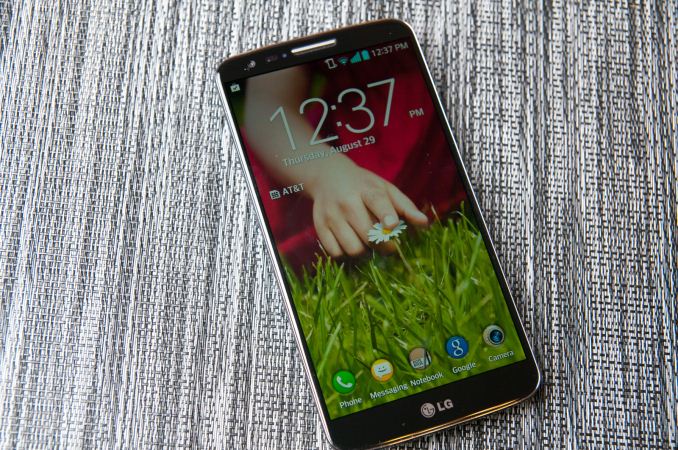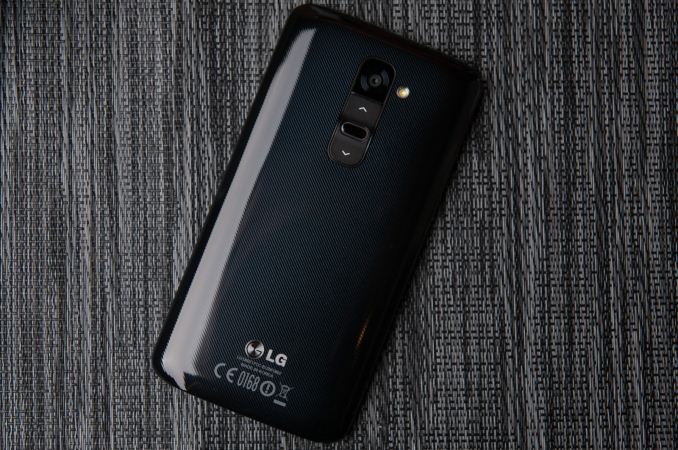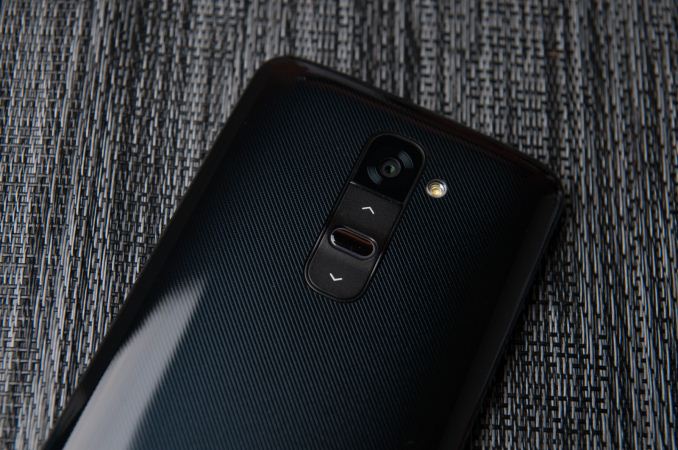LG G2 and MSM8974 Snapdragon 800 - Mini Review
by Brian Klug on September 7, 2013 1:11 AM EST- Posted in
- Smartphones
- LG
- Mobile
- LG G2
- Android 4.2
- MSM8974
- Snapdragon 800

The LG G2 is the spiritual successor to the Optimus G, a device that we looked at last year and eventually went on to become the Nexus 4. LG dropped the "Optimus" branding this time, but the G2 is without a doubt still LG's flagship smartphone, and includes a number of unique LG features – stacked 3000 mAh (11.4 Whr) battery with SiO+ anode, 5.2-inch 1080p LCD from LG Display, and 13 MP rear facing camera with OIS (Optical Image Stabilization). It's an impressive combination of features that make the G2 a standout device. At the same time the G2 is our first chance to get a look at the 2.3 GHz bin of Snapdragon 800 inside a shipping device and get a look at performance and battery life.
We took a quick look at the G2 at the announcement event, now we have our hands on a G2 and have been putting it through its paces, benchmarking it, and running battery life tests on it for a little under a week and wanted to share some thoughts.
Hardware Impressions
The G2 marries a curved backside shape with front glass that slightly curves at the edges and has a very narrow side bezel. The G2 also opts for on-screen buttons rather than the discrete capacitive kind or physical buttons that went out of favor a while ago. The reality is that Google does have a fair amount of input into at least this part of the Android ecosystem, and its guidance seems to be that on-screen buttons which use display real estate to draw the buttons is the recommended way to go. The G2 does afford the ability however to add Quick Memo buttons or the notification shade pull down/pull up buttons to the bar, but oddly enough there's no multitasking button option available.
The G2 manages to include a large display without width that's much different from other devices I've been using lately, like the HTC One. Part of getting the edge bezel small was a reduction in volume required on the sides for volume and power buttons, which are instead moved to the back of the G2, perhaps its most striking and initially even alarming design change.
Holding down the volume down button launches you into the camera, pressing the center button powers on the phone, and holding down the top button launches QuickMemo. Up and down are volume up and down otherwise. There's a hard raised lip on both sides of the button too, so the G2 when laid backside down on a surface makes contact there instead of on the button – it won't inadverntely turn on when pressed against a table. I found the backside buttons easy to adapt to after my first few interactions with the G2, and they actually become second nature after a day or so. The raised bump for the power button makes it easy to locate with the index finger, and I haven't smeared or accidentally put my finger on the sapphire camera cover yet. If the power button on the back is still difficult to get used to, the G2 has a double tap to turn on feature it calls "knock knock" – double tap on the display, and the G2 will turn on, repeat the double tap on the status bar or in an empty part of the display when it's on, and it turns off. I find myself using the double tap gesture quite a bit to turn the G2 on and off. I believe this functionality uses the sensors onboard and the DSP inside 8974 to detect when the taps occur.
The G2 I was sampled is a dark blue color which has a slight pinstripe on the back as shown in the photos above. The material is however the same kind of glossy plastic I'm used to seeing out of the Korean handset makers of note, and picks up fingerprints and hand oil very quickly unfortunately. I like the shape of the device and LG's innovations, it's just puzzling to me that materials hasn't picked up yet, I'd even take glass from the Optimus G over plastic. I'll save you the huge discussion on device size as well, I'm fine with the larger smartphones that aren't quite phablets, and the G2 for me is totally usable and I appreciate the increased display size. It definitely isn't phablet size, but it is on the larger high-end smartphone side of things.
| LG G2 | |
| SoC |
Qualcomm Snapdragon 800 (MSM8974) 4x Krait 400 2.3 GHz, Adreno 330 GPU |
| Display | 5.2-inch IPS-LCD 1920x1080 Full HD |
| RAM | 2GB LPDDR3 800 MHz |
| WiFi | 802.11a/b/g/n/ac, BT 4.0 |
| Storage | 32 GB internal |
| I/O | microUSB 2.0, 3.5mm headphone, NFC, Miracast, IR |
| OS | Android 4.2.2 |
| Battery | 3000 mAh (11.4 Whr) 3.8V stacked battery |
| Size / Mass | 138.5 x 70.9 x 9.14 mm |
| Camera |
13 MP with OIS and Flash (Rear Facing) 2.1 MP Full HD (Front Facing) |



















120 Comments
View All Comments
KurianOfBorg - Saturday, September 7, 2013 - link
What about the suttering and lag? I used the Optimus G Pro and it stuttered and lagged everywhere. No where close to the smoothness of the Nexus 4.Brian Klug - Saturday, September 7, 2013 - link
I find it to be really smooth, of course if you want absolute smoothness, you can just wait for 8974 in the Nexus 5 :)-Brian
htotfalitm - Saturday, September 7, 2013 - link
good. I'm glad they ditched capacitive controlsI hated onscreen controls too but I've been completely sold on the idea since I tried Paranoid Android and discovered Pie Control
baronmog - Saturday, September 7, 2013 - link
I feel like a broken record: only 32GB onboard storage and no microSD? No thanks. I really, really, really, wish someone other than Samsung would get their heads out of the cloud. It's ok when you're someplace with decent, or any, wireless connectivity. Otherwise, useless.HideOut - Saturday, September 7, 2013 - link
I want to trade off my S4 for this...but no microSD? FAIL.BabelHuber - Saturday, September 7, 2013 - link
Exactly my thoughts!When I see reviews at Anandtech, often my first thought is 'wow, what a nice phone!'-
Then I see that the SD-card is missing and the phone has died for me.
Samsung seems to be very smart in this area. They always have removable batteries, SD-card support and unlocked bootloaders.
And while Samsung breaks one sales record after another quarter by quarter, LG and HTC are wondering why most customers prefer their competitor's devices.
I don't think that this is coincidence. E.g. I personally like the look and feel of the HTC One, but the lacking flexibility turned me off immediately.
Android games like the Asphalt-series consume about 1.5GB meanwhile. A 16GB phone without SD-card support is a joke meanwhile.
32GB are OK, but still inferiour to an external 64GB SD-card. Once you root your device, you can set mount points to the external SD-card or - in case you are lazy like me - use an app like FolderMount to at least move the apps which are memory-hogs to the external SD.
How much can it cost to support such a feature? LG, HTC etc. are clueless and deserve their low market share with their crippled devices, really.
They should wake up and support SD-cards so we get more competition. But no, instead the champaign flows at Samsung while the managers laugh about the competition.
maximumGPU - Saturday, September 7, 2013 - link
You're talking as if LG and HTC's low market share is attributable to lack of SD support. It has practically nothing to do with this.You do understand that people requesting SD support are a minority that barely register in sales number?
BabelHuber - Saturday, September 7, 2013 - link
This is what I always hear. But I do not believe this.Why are people buying 70 Million Samsung smartphones per quarter, then? Just because 'Samsung' is printed on them?
In basically every store, HTC, Samsung, LG and Sony phones are sold. People walk in and mostly buy Samsung.
And this has nothing to do with the additional features Samsung offers for the same price? Come on!
UpSpin - Saturday, September 7, 2013 - link
Just take a look at how much money Samsung spends on advertising, then you'll understand why the Samsung smartphones are the most sold ones.http://www.imore.com/samsung-spending-ludicrously-...
http://online.wsj.com/article/SB100014241278873240...
Most people really don't care about SD-Cards, for some it's even an annoyance because you can't combine the phone storage with the SD-Card storage, so you can't use it for apps and other stuff. And it's much slower than eMMC and another part which can and will fail after extensive usage.
Thus a phone with 8GB internal + 64GB SD-Card is almost as worthless as a phone with 8GB only for the !majority of people!
The big advantage comes with storing music libraries, movie libraries, ... on the SD-Card, but there again, the majority of users does not have a 64GB music library, and barely DVD/Blu-Ray rips, they rather rely on streaming.
BabelHuber - Saturday, September 7, 2013 - link
First of all, I already have posted that using the SD-card for apps is child's play after the phone has been rooted. Just root, install FoulderMount and off you go.Then you can use the SD-card for Music, movies etc., while music probably being the major use-case for most people, as a solt of people use their phone as 'walkman' or use it as music data storage in their cars.
So simply stating that an SD-card does not give you benefits ist BS.
And yes, marketing is an explanation for higher market share. But this alone does not explain why Samsung has ten times the marketshare of its competitors.
Tomi Ahonen called the smartphone market 'Samsung, Apple and the nine dwarfes', which is correct IMO.
A lot of people walk into a store and don't have much clue. Then the sales guy shows them the phones and explains the advantages/ disadvantages.
So, if you are not much interested in the HTC One's speakers, you can also take the SGS4. It has a removable battery and an SD-card slot and costs the same.
Why take the phone with less options? It simply does not make sense - after all, if you never use the SD-card slot it does not matter because you payed no premium for it.
But simply stating that customers are too stupid to properly use SD-cards falls short when Samsung has so much success with phones equipped with such features.